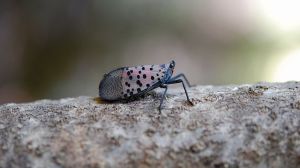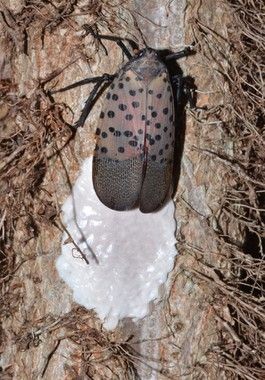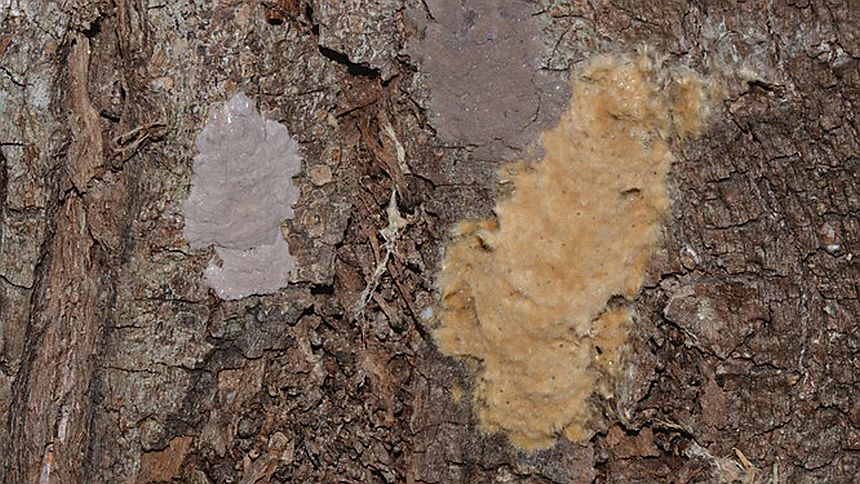New Fruit Pest Threat Found In Pennsylvania

(Photo credit: Dana Rhodes Pennsylvania Department of Agriculture)
This fall an invasive pest was detected in Berks County, PA, for the first time in the U.S. This invasive pest, native to China, Indian, Japan, and Vietnam, has been quite destructive in Korea since 2006.
The spotted lanternfly, Lycorma delicatula, is an inch-long black, red, and white-spotted pest. It attacks the woody tissue on grapes, apples, peaches, pines, and many other species of trees and shrubs.
The Pennsylvania Department of Agriculture is taking the threat of this pest very seriously, given its propensity to attack trees and vines, and its history of rapidly spreading in Korea.
“My counterparts in Korea, and Korean literature indicate that the pest that the pest spread rapidly throughout the country in only a few years’ time,” Sven-Erik Spichiger, entomology program manager with the Pennsylvania Department of Agriculture, says.
Researchers also fear this pest’s rapid spread because it feasts on a smorgasbord of crops.
“Because there are so many hosts for the insects, which include fruit trees, ornamentals, grape, and hardwoods, we believe this is a threat to be taken seriously,” Dana Rhodes, state plant regulatory official with the Pennsylvania Department of Agriculture says. “We still have many questions to answer about the pest, but we are hopeful that early detection and the small [infestation] area we know where it is present will allow for control and possible eradication.”

A female spotted lanternfly laying an egg mass. Newly laid egg masses are somewhat shiny — covered in a waxy coating. (Photo credit: Greg Hoover, Penn State University)
What It Does
The spotted lanternfly is known to pierce puncture grapevines, causing sap to run down the vine. This weakens the vine and slows down production, says Rhodes. Mortality may ensue if the insects are left alone.
Sooty mold will also be present around the plant or tree. Other insects will attack the weakened vine or tree, causing more host plant stress.
“If growers notice excessive sap flowing from the trunks or vines they should inspect carefully for the insect,” Rhodes says. “People should be careful when inspecting because bees, wasps, and yellow jackets may be very active around the oozing sap locations.”
Spotting Egg Masses
There are different life stages of the spotted lanternfly, say entomologists with the Pennsylvania Department of Agriculture. Females lay eggs in clusters of 30-50 eggs beginning late August or September, until freezing temperatures.
These egg masses have a gray waxy mud-like coating and hatched eggs appear like brownish seed-shaped deposits in four to seven columns.
Egg masses are often seen on flat surfaces such as vehicles, crates, pallets, containers, and tree trunks. They are visible through the winter. These masses should be scraped off the surfaces and destroyed. Eggs are believed to begin hatching in mid-to-late May.
This insect only produces one generation.
“The nymphs have two distinct looks until they molt into adults, which should be late July or August,” says Rhodes.
Any life stages which are found should be reported to the state department of agriculture.

A gypsy moth egg mass (right) next to an egg mass of the spotted lanternfly (left) on a tree trunk. Egg cases of the spotted lanternfly can be found on tree bark and other nearby smooth surfaces. They are about 1-1.5 inches long and ½ -3/4 inches wide. They are gray-brown in color. (Photo credit: Greg Hoover, Penn State University)
What To Look Out For
Growers are encouraged to scout for egg masses. Although no egg masses have been found in vineyards or peach or apple orchards, they are difficult to identify.
“Even on an apple branch or trunk, that grayish color to the bark, and if it is an older tree and if there are lichens on it, it is not going to be an easily-scouted for pest,” says Greg Hoover, ornamental entomologist with Penn State University.
Hoover says that peach growers should be particularly diligent.
“Based on Korean literature, [entomologists] really see them frequently on peaches,” he says.
The other troubling piece to the puzzle is what entomologists believed was the lethal winter temperature for the spotted lanternfly — based on Korean literature — was easily reached last year.
“We can’t utilize that as our low temperature threshold, the population has already demonstrated that it can survive below that,” Hoover says. “We know that because there are old egg masses there. It’s been here at least two years.”
Small Area For Now
As of now the spotted lanternfly-infested area has a radius of approximately 20 square miles.
“An opportunity for eradication exists,” Spichiger says.
Just as easy as it would be to eliminate the threat of this pest, the spotted lanternfly can spread. Egg masses, if not observed, could be unintentionally moved out of the quarantine area and spread the pest.
“If they are not removed, they will ship out of the quarantine and will spread this pest to new areas,” Rhodes Rhoads says. “For growers who are familiar with the Gypsy Moth Federal Quarantine and looking for egg masses, this is a similar inspection.”
For entomologists and researchers alike, the 2015 growing season will be one of learning more about this new pest.
“We need to know more about this insect, and we know very little,” Hoover says. “We have a huge amount of unanswered questions and we start [answering them] this spring.”
For More Information
Since this is a new pest, resources for growers are limited and no pesticides are currently labeled to control the spotted lanternfly.
Researchers and entomologists from the Pennsylvania Department of Agriculture, USDA, and Penn State University’s department of entomology are working together to develop symptoms for growers to look out for, treatment options and best management practices.
Dana Rhodes, state plant regulatory official with the Pennsylvania Department of Agriculture, suggests growers visit PDA.State.PA.US/SpottedLanternfly for more information.
Also Penn State University Extension offers a slideshow to help growers identify this new pest.










